2010 INFINITI QX56 transmission oil
[x] Cancel search: transmission oilPage 3826 of 4210
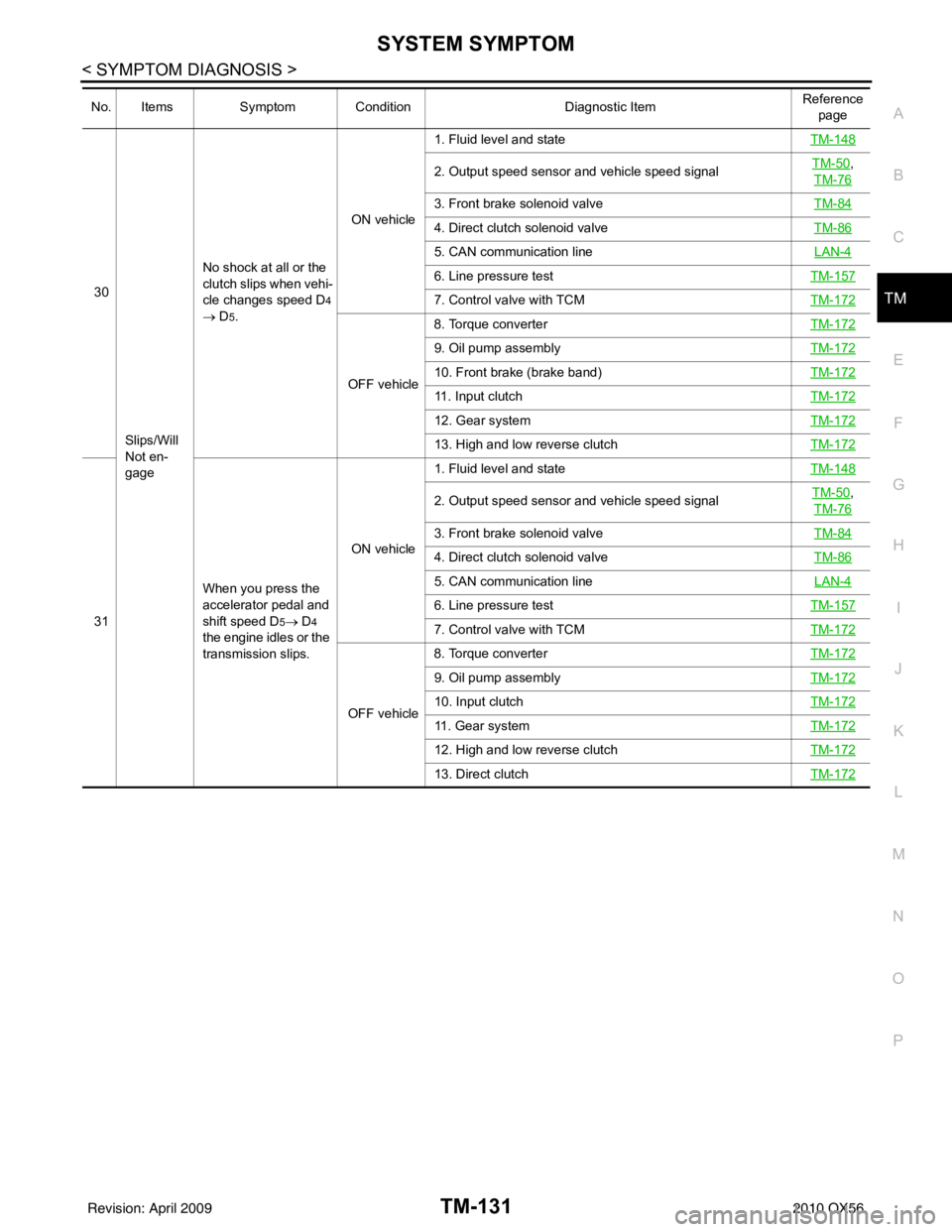
SYSTEM SYMPTOMTM-131
< SYMPTOM DIAGNOSIS >
CEF
G H
I
J
K L
M A
B
TM
N
O P30
Slips/Will
Not en-
gage No shock at all or the
clutch slips when vehi-
cle changes speed D4
→
D5. ON vehicle
1. Fluid level and state
TM-148
2. Output speed sensor and vehicle speed signal TM-50,
TM-76
3. Front brake solenoid valve TM-84
4. Direct clutch solenoid valveTM-86
5. CAN communication line LAN-4
6. Line pressure testTM-157
7. Control valve with TCMTM-172
OFF vehicle8. Torque converter
TM-172
9. Oil pump assemblyTM-172
10. Front brake (brake band)TM-172
11. Input clutchTM-172
12. Gear systemTM-172
13. High and low reverse clutchTM-172
31When you press the
accelerator pedal and
shift speed D5→ D4
the engine idles or the
transmission slips. ON vehicle
1. Fluid level and state
TM-148
2. Output speed sensor and vehicle speed signal TM-50,
TM-76
3. Front brake solenoid valve TM-84
4. Direct clutch solenoid valveTM-86
5. CAN communication line LAN-4
6. Line pressure testTM-157
7. Control valve with TCMTM-172
OFF vehicle8. Torque converter
TM-172
9. Oil pump assemblyTM-172
10. Input clutchTM-172
11. Gear systemTM-172
12. High and low reverse clutchTM-172
13. Direct clutchTM-172
No. ItemsSymptom Condition Diagnostic ItemReference
page
Revision: April 20092010 QX56
Page 3827 of 4210
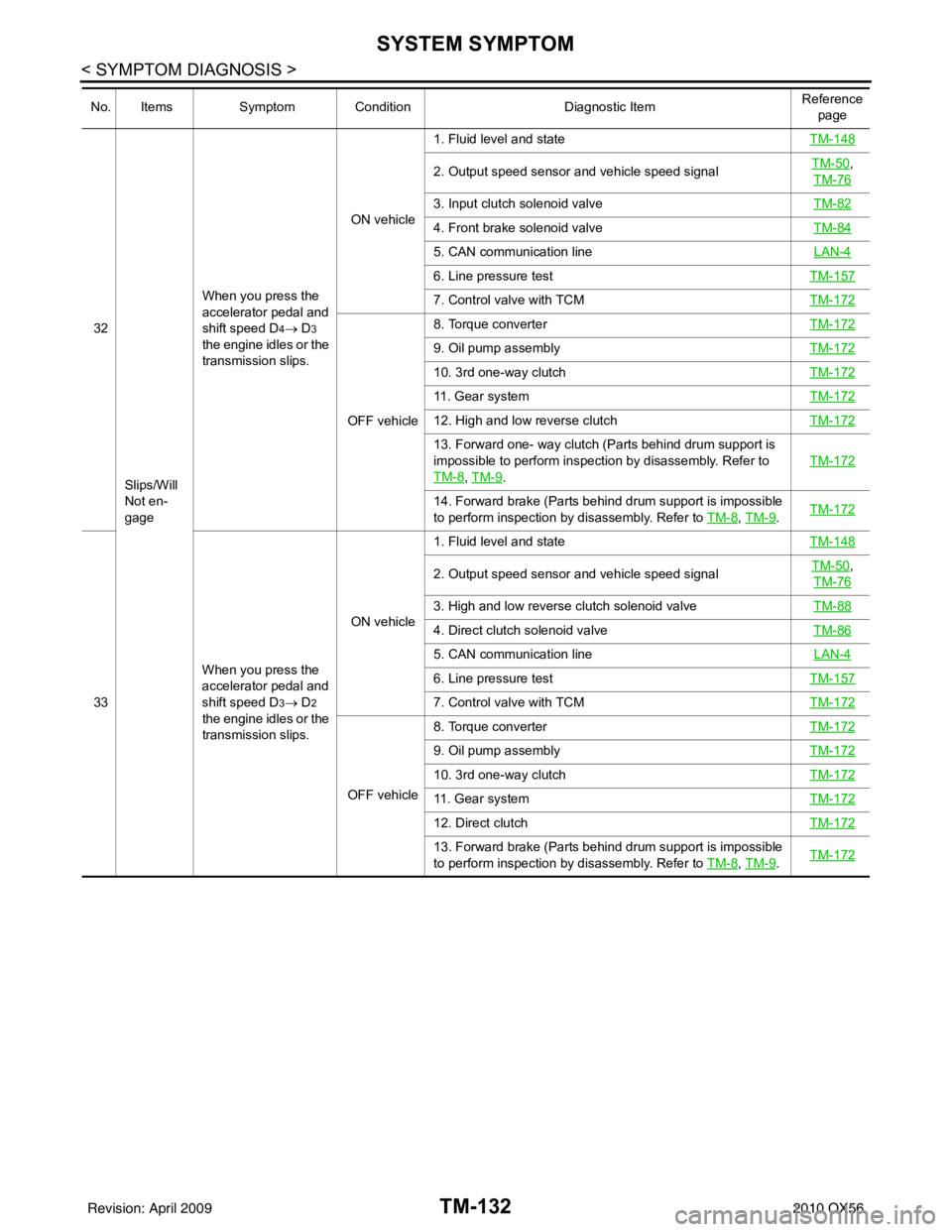
TM-132
< SYMPTOM DIAGNOSIS >
SYSTEM SYMPTOM
32Slips/Will
Not en-
gage When you press the
accelerator pedal and
shift speed D4→ D3
the engine idles or the
transmission slips. ON vehicle
1. Fluid level and state
TM-148
2. Output speed sensor and vehicle speed signal TM-50,
TM-76
3. Input clutch solenoid valve TM-82
4. Front brake solenoid valveTM-84
5. CAN communication line LAN-4
6. Line pressure testTM-157
7. Control valve with TCMTM-172
OFF vehicle8. Torque converter
TM-172
9. Oil pump assemblyTM-172
10. 3rd one-way clutchTM-172
11. Gear systemTM-172
12. High and low reverse clutchTM-172
13. Forward one- way clutch (Parts behind drum support is
impossible to perform inspection by disassembly. Refer to
TM-8
, TM-9. TM-172
14. Forward brake (Parts behind drum support is impossible
to perform inspection by disassembly. Refer to
TM-8
, TM-9. TM-172
33 When you press the
accelerator pedal and
shift speed D3→ D2
the engine idles or the
transmission slips. ON vehicle
1. Fluid level and state
TM-148
2. Output speed sensor and vehicle speed signal TM-50,
TM-76
3. High and low reverse clutch solenoid valve TM-88
4. Direct clutch solenoid valveTM-86
5. CAN communication line LAN-4
6. Line pressure testTM-157
7. Control valve with TCMTM-172
OFF vehicle8. Torque converter
TM-172
9. Oil pump assemblyTM-172
10. 3rd one-way clutchTM-172
11. Gear systemTM-172
12. Direct clutchTM-172
13. Forward brake (Parts behind drum support is impossible
to perform inspection by disassembly. Refer to TM-8
, TM-9. TM-172
No. Items
Symptom Condition Diagnostic ItemReference
page
Revision: April 20092010 QX56
Page 3828 of 4210
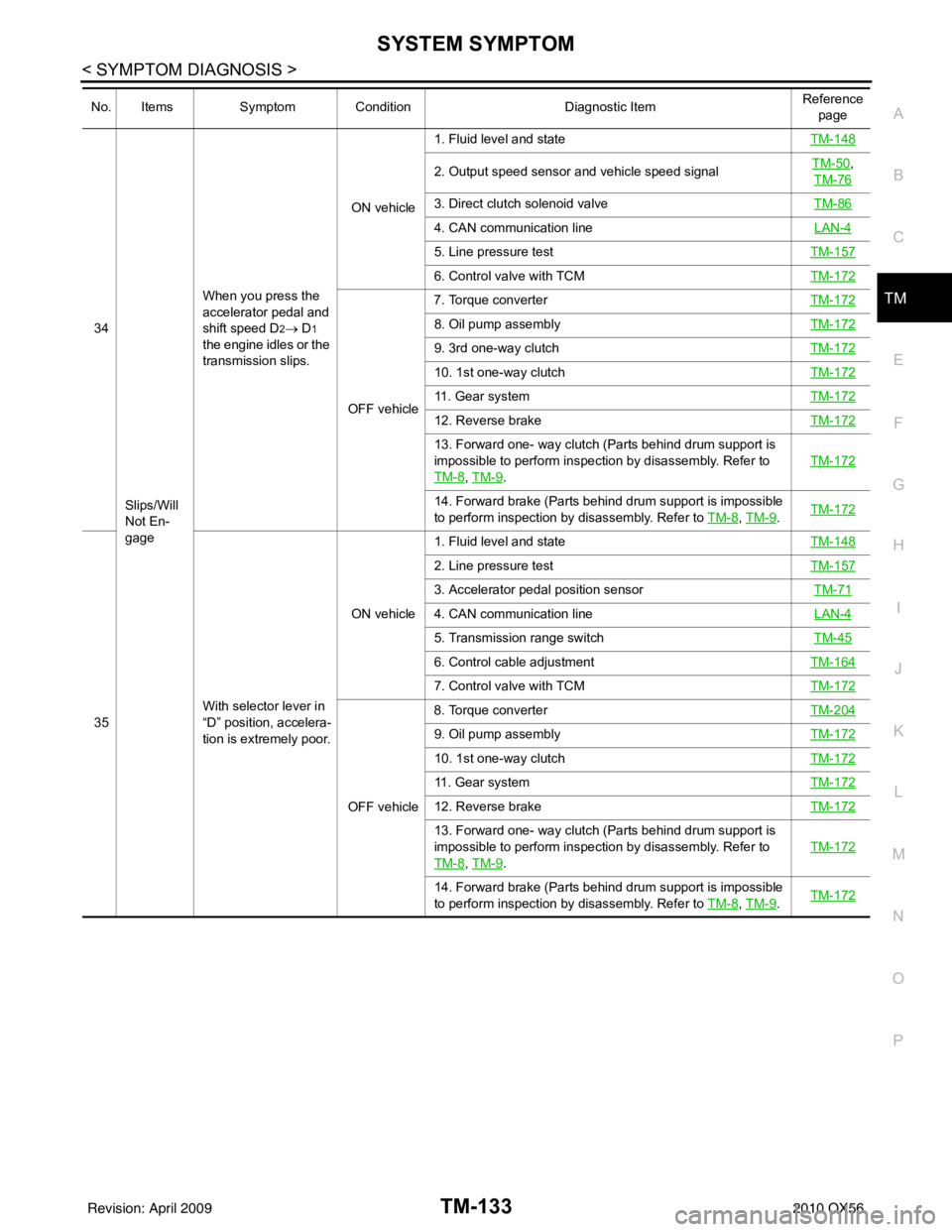
SYSTEM SYMPTOMTM-133
< SYMPTOM DIAGNOSIS >
CEF
G H
I
J
K L
M A
B
TM
N
O P
34
Slips/Will
Not En-
gage When you press the
accelerator pedal and
shift speed D2→ D1
the engine idles or the
transmission slips. ON vehicle
1. Fluid level and state
TM-148
2. Output speed sensor and vehicle speed signal TM-50,
TM-76
3. Direct clutch solenoid valve TM-86
4. CAN communication line LAN-4
5. Line pressure testTM-157
6. Control valve with TCMTM-172
OFF vehicle7. Torque converter
TM-172
8. Oil pump assemblyTM-172
9. 3rd one-way clutchTM-172
10. 1st one-way clutchTM-172
11. Gear systemTM-172
12. Reverse brakeTM-172
13. Forward one- way clutch (Parts behind drum support is
impossible to perform inspection by disassembly. Refer to
TM-8
, TM-9.TM-172
14. Forward brake (Parts behind drum support is impossible
to perform inspection by disassembly. Refer to
TM-8
, TM-9. TM-172
35 With selector lever in
“D” position, accelera-
tion is extremely poor. ON vehicle
1. Fluid level and state
TM-148
2. Line pressure testTM-157
3. Accelerator pedal position sensor TM-71
4. CAN communication line LAN-4
5. Transmission range switchTM-45
6. Control cable adjustmentTM-164
7. Control valve with TCMTM-172
OFF vehicle8. Torque converter
TM-204
9. Oil pump assemblyTM-172
10. 1st one-way clutchTM-172
11. Gear systemTM-172
12. Reverse brakeTM-172
13. Forward one- way clutch (Parts behind drum support is
impossible to perform inspection by disassembly. Refer to
TM-8
, TM-9.TM-172
14. Forward brake (Parts behind drum support is impossible
to perform inspection by disassembly. Refer to
TM-8
, TM-9. TM-172
No. Items
Symptom Condition Diagnostic ItemReference
page
Revision: April 20092010 QX56
Page 3829 of 4210
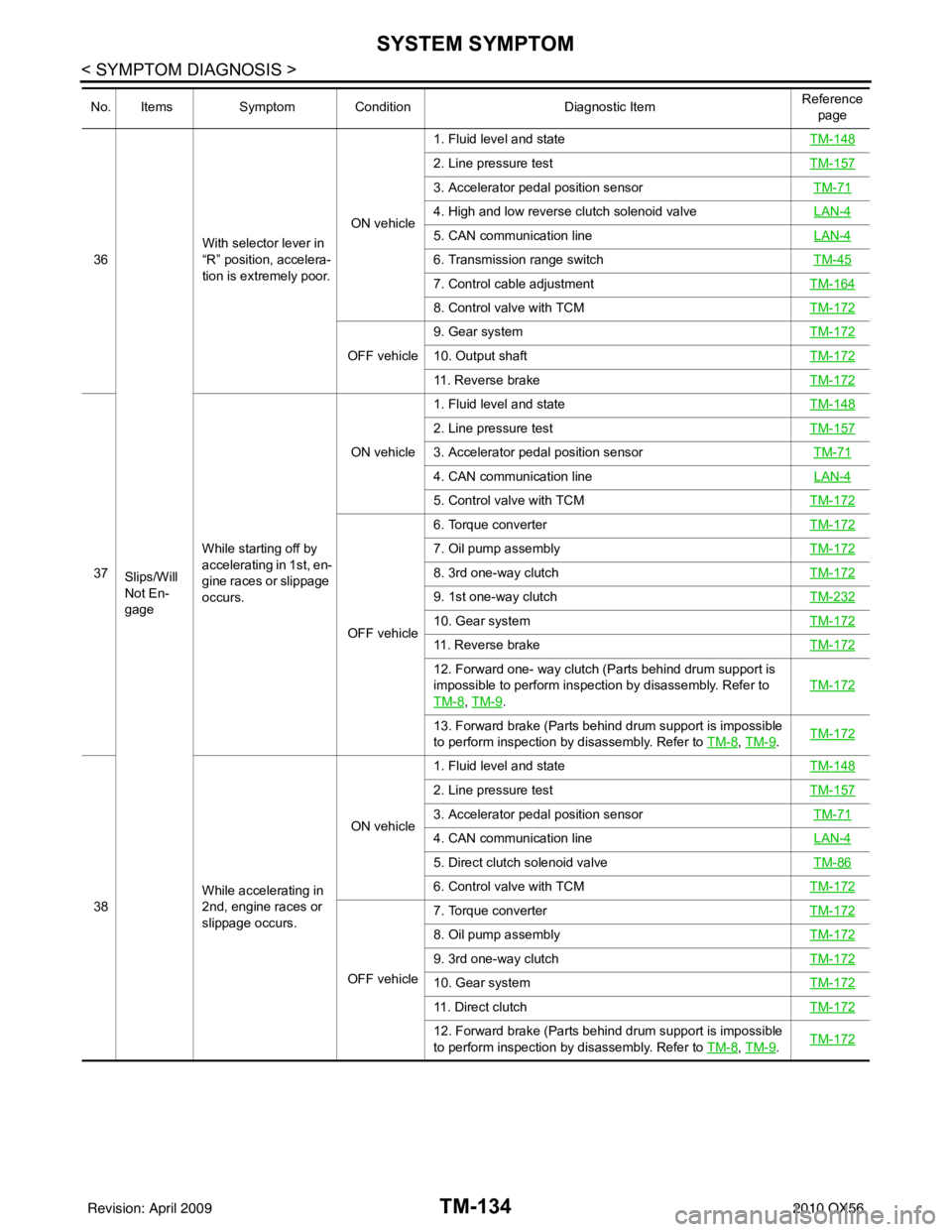
TM-134
< SYMPTOM DIAGNOSIS >
SYSTEM SYMPTOM
36Slips/Will
Not En-
gage With selector lever in
“R” position
, accelera-
tion is extremely poor. ON vehicle1. Fluid level and state
TM-148
2. Line pressure testTM-157
3. Accelerator pedal position sensor TM-71
4. High and low reverse clutch solenoid valve LAN-4
5. CAN communication lineLAN-4
6. Transmission range switchTM-45
7. Control cable adjustmentTM-164
8. Control valve with TCMTM-172
OFF vehicle9. Gear system
TM-17210. Output shaftTM-172
11. Reverse brakeTM-172
37While starting off by
accelerating in 1st, en-
gine races or slippage
occurs. ON vehicle
1. Fluid level and state
TM-148
2. Line pressure testTM-157
3. Accelerator pedal position sensor TM-71
4. CAN communication line LAN-4
5. Control valve with TCMTM-172
OFF vehicle6. Torque converter
TM-172
7. Oil pump assemblyTM-172
8. 3rd one-way clutchTM-172
9. 1st one-way clutchTM-232
10. Gear systemTM-172
11. Reverse brakeTM-172
12. Forward one- way clutch (Parts behind drum support is
impossible to perform inspection by disassembly. Refer to
TM-8
, TM-9. TM-172
13. Forward brake (Parts behind drum support is impossible
to perform inspection by disassembly. Refer to
TM-8
, TM-9. TM-172
38 While accelerating in
2nd, engine races or
slippage occurs. ON vehicle
1. Fluid level and state
TM-148
2. Line pressure testTM-157
3. Accelerator pedal position sensor TM-71
4. CAN communication line LAN-4
5. Direct clutch solenoid valveTM-86
6. Control valve with TCMTM-172
OFF vehicle7. Torque converter
TM-172
8. Oil pump assemblyTM-172
9. 3rd one-way clutchTM-172
10. Gear systemTM-172
11. Direct clutchTM-172
12. Forward brake (Parts behind drum support is impossible
to perform inspection by disassembly. Refer to TM-8
, TM-9. TM-172
No. Items
Symptom Condition Diagnostic ItemReference
page
Revision: April 20092010 QX56
Page 3831 of 4210
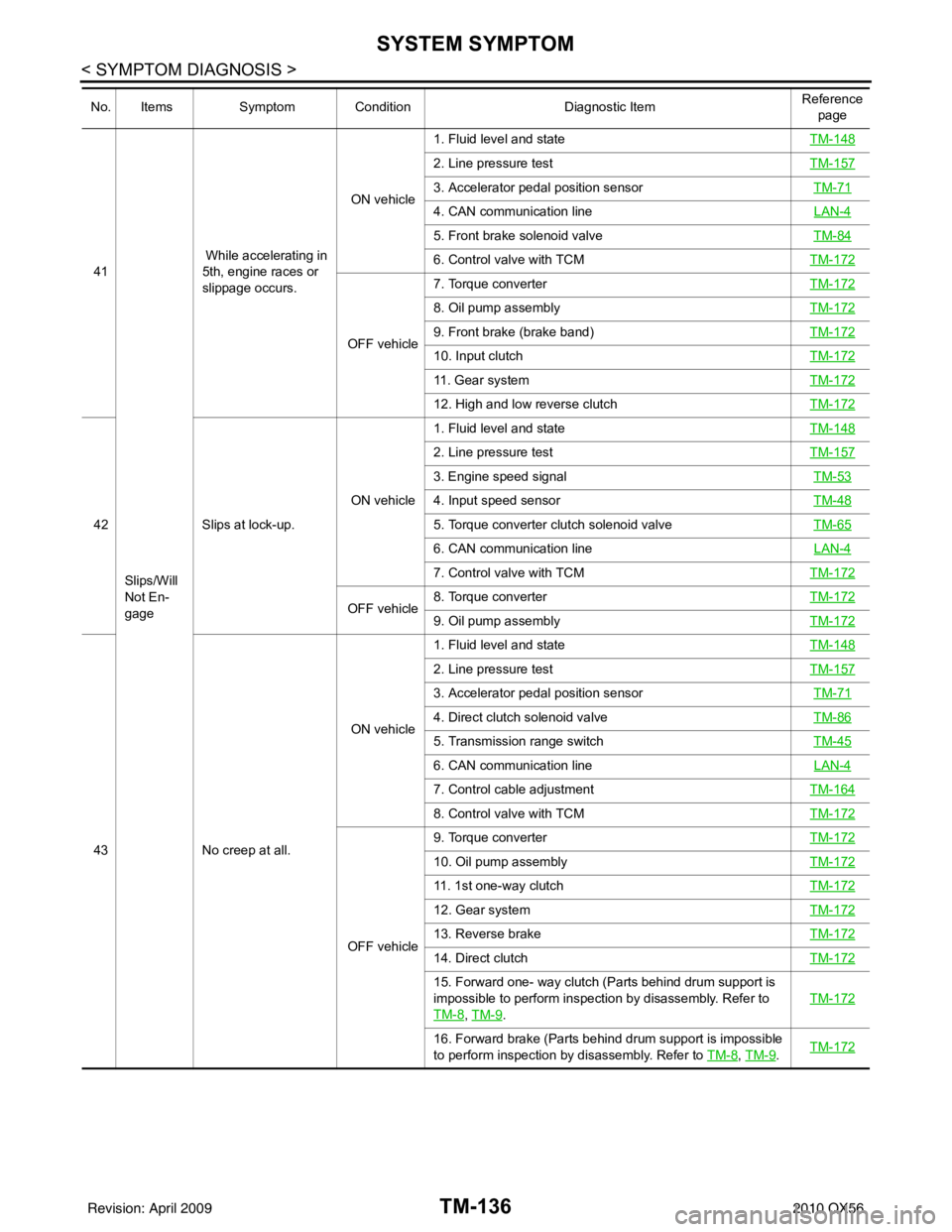
TM-136
< SYMPTOM DIAGNOSIS >
SYSTEM SYMPTOM
41Slips/Will
Not En-
gage While accelerating in
5th, engine races or
slippage occurs.
ON vehicle
1. Fluid level and state
TM-148
2. Line pressure testTM-157
3. Accelerator pedal position sensor TM-71
4. CAN communication line LAN-4
5. Front brake solenoid valveTM-84
6. Control valve with TCMTM-172
OFF vehicle7. Torque converter
TM-172
8. Oil pump assemblyTM-172
9. Front brake (brake band)TM-172
10. Input clutchTM-172
11. Gear systemTM-172
12. High and low reverse clutchTM-172
42Slips at lock-up. ON vehicle1. Fluid level and state
TM-148
2. Line pressure testTM-157
3. Engine speed signal TM-53
4. Input speed sensorTM-48
5. Torque converter clutch solenoid valveTM-65
6. CAN communication line LAN-4
7. Control valve with TCMTM-172
OFF vehicle8. Torque converter
TM-1729. Oil pump assemblyTM-172
43No creep at all. ON vehicle
1. Fluid level and state
TM-148
2. Line pressure testTM-157
3. Accelerator pedal position sensor TM-71
4. Direct clutch solenoid valveTM-86
5. Transmission range switchTM-45
6. CAN communication line LAN-4
7. Control cable adjustmentTM-164
8. Control valve with TCMTM-172
OFF vehicle9. Torque converter
TM-172
10. Oil pump assemblyTM-172
11. 1st one-way clutchTM-172
12. Gear systemTM-172
13. Reverse brakeTM-172
14. Direct clutchTM-172
15. Forward one- way clutch (Parts behind drum support is
impossible to perform inspection by disassembly. Refer to
TM-8
, TM-9. TM-172
16. Forward brake (Parts behind drum support is impossible
to perform inspection by disassembly. Refer to
TM-8
, TM-9. TM-172
No. Items
Symptom Condition Diagnostic ItemReference
page
Revision: April 20092010 QX56
Page 3832 of 4210
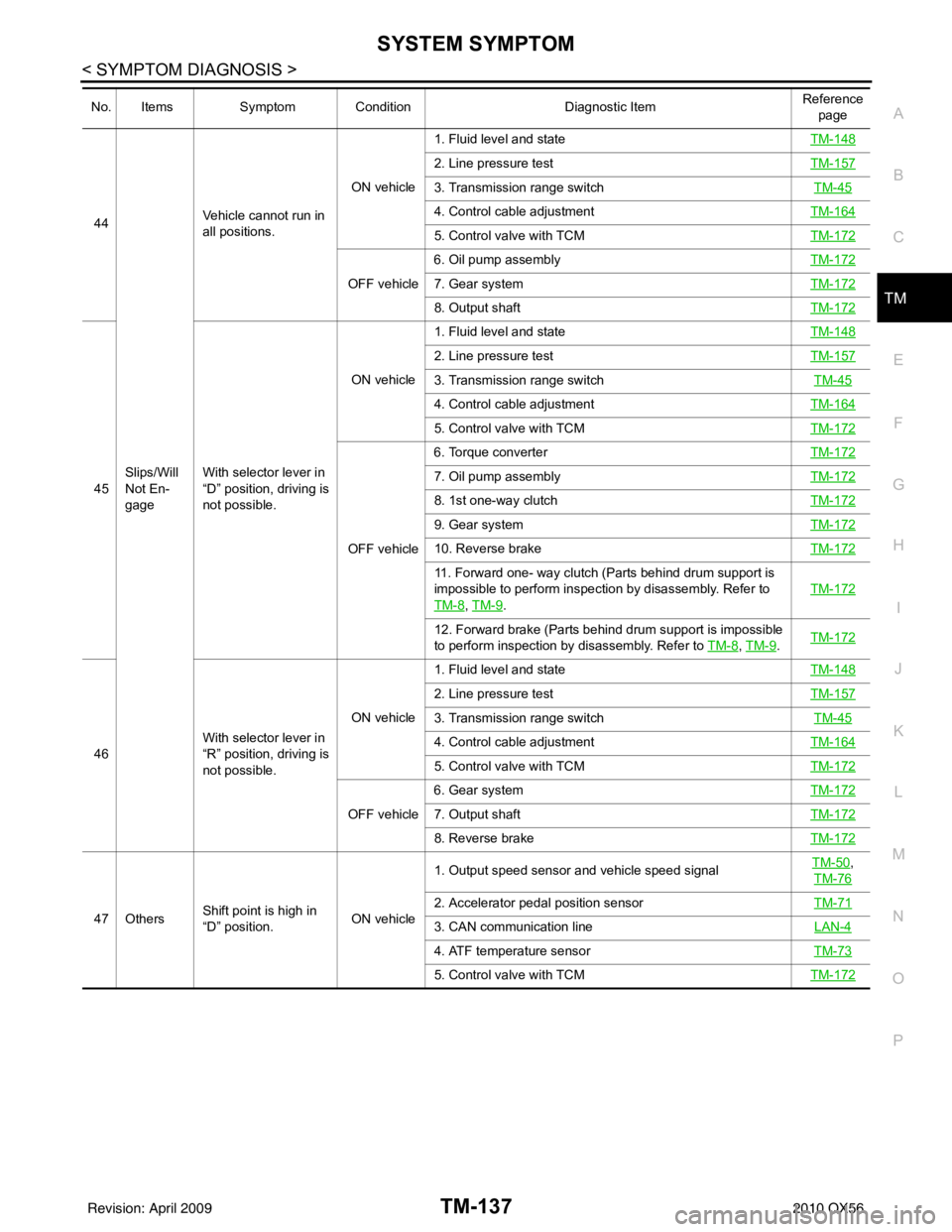
SYSTEM SYMPTOMTM-137
< SYMPTOM DIAGNOSIS >
CEF
G H
I
J
K L
M A
B
TM
N
O P
44
Slips/Will
Not En-
gage Vehicle cannot run in
all positions.
ON vehicle1. Fluid level and state
TM-148
2. Line pressure testTM-157
3. Transmission range switch TM-45
4. Control cable adjustmentTM-164
5. Control valve with TCMTM-172
OFF vehicle6. Oil pump assembly
TM-1727. Gear systemTM-172
8. Output shaftTM-172
45With selector lever in
“D” position, driving is
not possible. ON vehicle
1. Fluid level and state
TM-148
2. Line pressure testTM-157
3. Transmission range switch TM-45
4. Control cable adjustmentTM-164
5. Control valve with TCMTM-172
OFF vehicle6. Torque converter
TM-172
7. Oil pump assembly TM-172
8. 1st one-way clutchTM-172
9. Gear systemTM-172
10. Reverse brakeTM-172
11. Forward one- way clutch (Parts behind drum support is
impossible to perform inspection by disassembly. Refer to
TM-8
, TM-9.TM-172
12. Forward brake (Parts behind drum support is impossible
to perform inspection by disassembly. Refer to
TM-8
, TM-9. TM-172
46 With selector lever in
“R” position, driving is
not possible. ON vehicle
1. Fluid level and state
TM-148
2. Line pressure testTM-157
3. Transmission range switch TM-45
4. Control cable adjustmentTM-164
5. Control valve with TCMTM-172
OFF vehicle6. Gear system
TM-1727. Output shaftTM-172
8. Reverse brakeTM-172
47 OthersShift point is high in
“D” position. ON vehicle1. Output speed sensor and vehicle speed signal
TM-50
,
TM-76
2. Accelerator pedal position sensor TM-71
3. CAN communication line LAN-4
4. ATF temperature sensorTM-73
5. Control valve with TCMTM-172
No. ItemsSymptom Condition Diagnostic ItemReference
page
Revision: April 20092010 QX56
Page 3835 of 4210
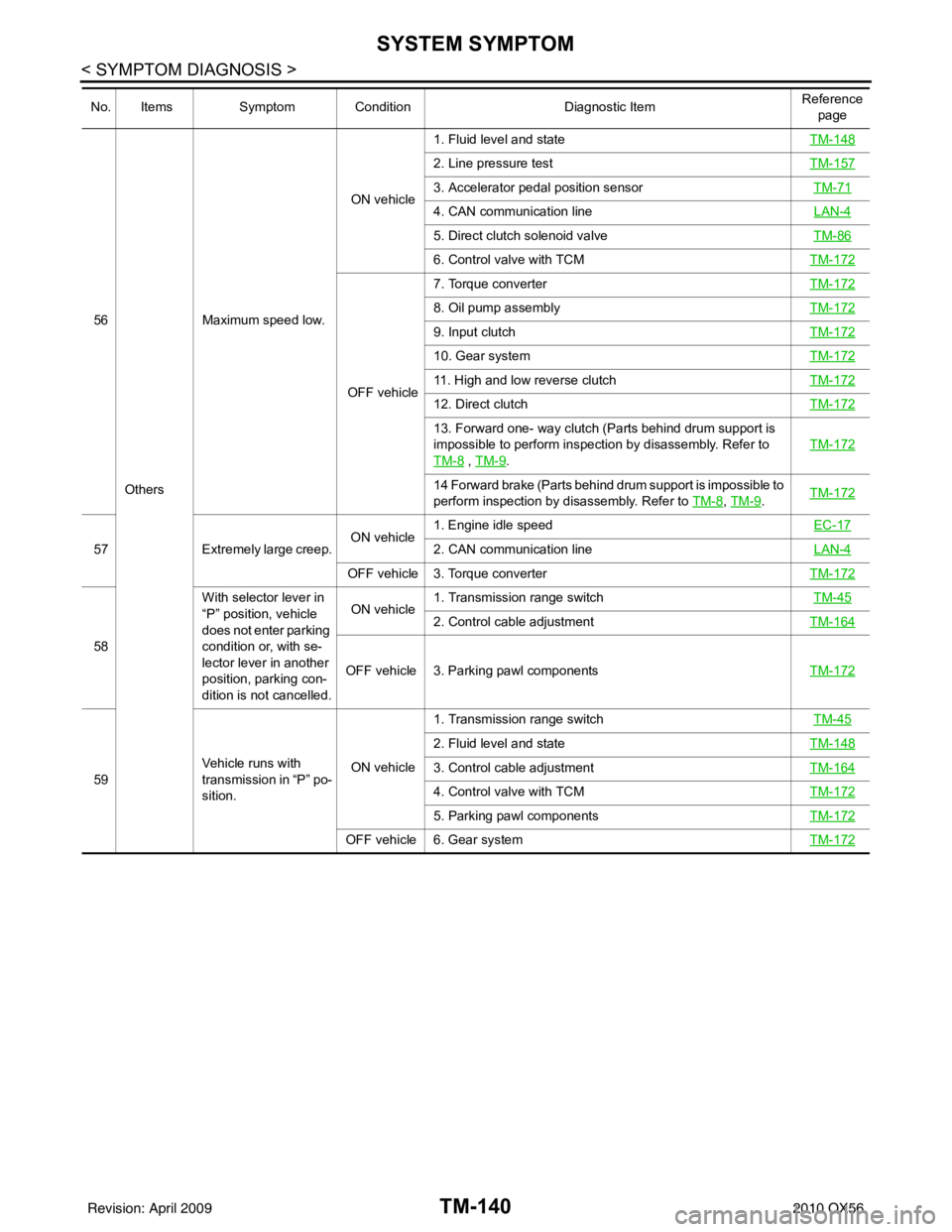
TM-140
< SYMPTOM DIAGNOSIS >
SYSTEM SYMPTOM
56Others Maximum speed low.
ON vehicle
1. Fluid level and state
TM-148
2. Line pressure testTM-157
3. Accelerator pedal position sensor TM-71
4. CAN communication line LAN-4
5. Direct clutch solenoid valveTM-86
6. Control valve with TCMTM-172
OFF vehicle7. Torque converter
TM-172
8. Oil pump assemblyTM-172
9. Input clutchTM-172
10. Gear systemTM-172
11. High and low reverse clutchTM-172
12. Direct clutchTM-172
13. Forward one- way clutch (Parts behind drum support is
impossible to perform inspection by disassembly. Refer to
TM-8
, TM-9. TM-172
14 Forward brake (Parts behind drum support is impossible to
perform inspection by disassembly. Refer to TM-8
,
TM-9. TM-172
57
Extremely large creep. ON vehicle1. Engine idle speed
EC-172. CAN communication lineLAN-4
OFF vehicle 3. Torque converter TM-172
58With selector lever in
“P” position, vehicle
does not enter parking
condition or, with se-
lector lever in another
position, parking con-
dition is not cancelled. ON vehicle
1. Transmission range switch
TM-45
2. Control cable adjustmentTM-164
OFF vehicle 3. Parking pawl components TM-172
59Vehicle runs with
transmission in “P” po-
sition. ON vehicle1. Transmission range switch
TM-45
2. Fluid level and stateTM-148
3. Control cable adjustmentTM-164
4. Control valve with TCMTM-172
5. Parking pawl componentsTM-172
OFF vehicle 6. Gear system TM-172
No. ItemsSymptom Condition Diagnostic ItemReference
page
Revision: April 20092010 QX56
Page 3839 of 4210
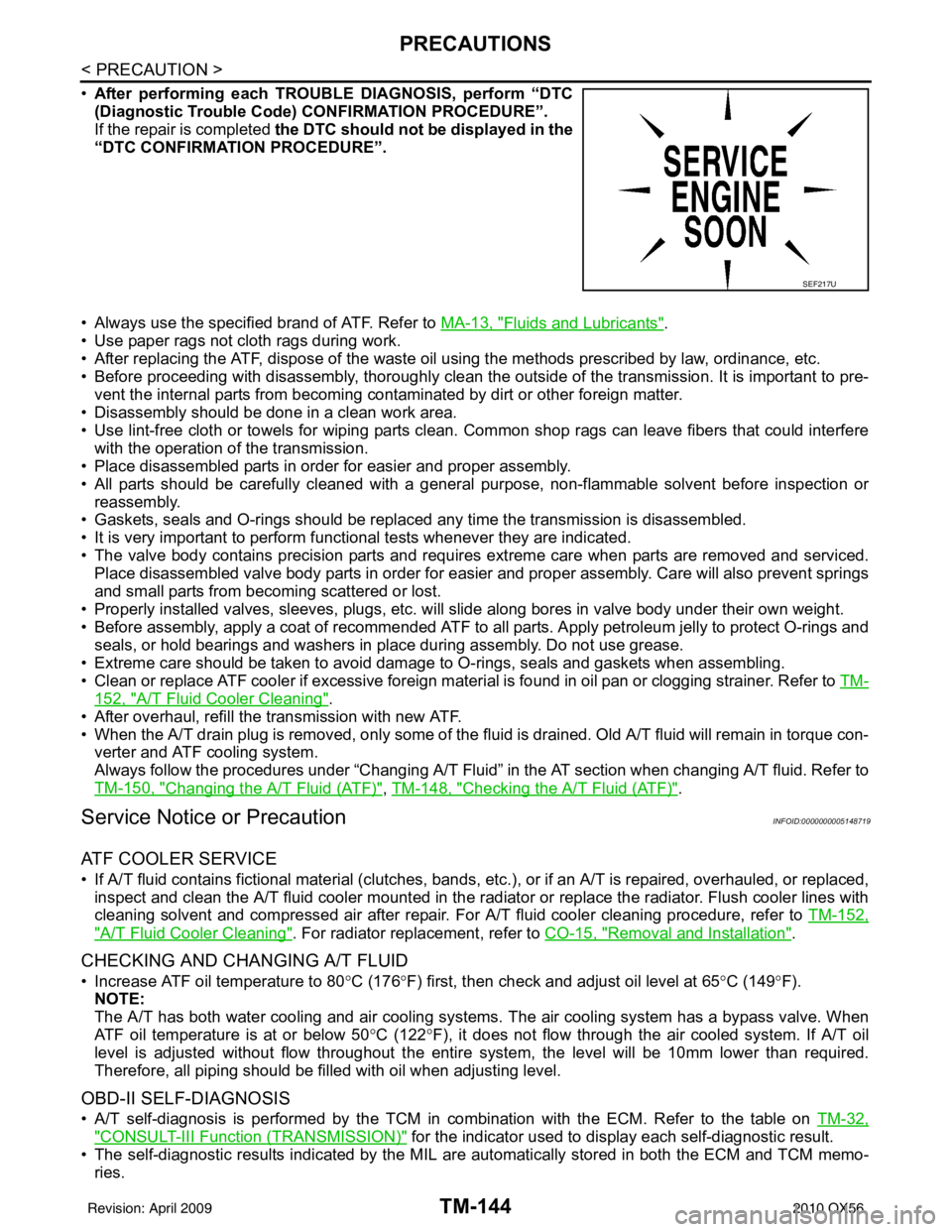
TM-144
< PRECAUTION >
PRECAUTIONS
•After performing each TROUBLE DIAGNOSIS, perform “DTC
(Diagnostic Trouble Code) CONFIRMATION PROCEDURE”.
If the repair is completed the DTC should not be displayed in the
“DTC CONFIRMATION PROCEDURE”.
• Always use the specified brand of ATF. Refer to MA-13, "
Fluids and Lubricants".
• Use paper rags not cloth rags during work.
• After replacing the ATF, dispose of the waste oil using the methods prescribed by law, ordinance, etc.
• Before proceeding with disassembly, thoroughly clean the outside of the transmission. It is important to pre- vent the internal parts from becoming cont aminated by dirt or other foreign matter.
• Disassembly should be done in a clean work area.
• Use lint-free cloth or towels for wiping parts clean. Common shop rags can leave fibers that could interfere
with the operation of the transmission.
• Place disassembled parts in order for easier and proper assembly.
• All parts should be carefully cleaned with a general purpose, non-flammable solvent before inspection or
reassembly.
• Gaskets, seals and O-rings should be replaced any time the transmission is disassembled.
• It is very important to perform functional tests whenever they are indicated.
• The valve body contains precision parts and requires extreme care when parts are removed and serviced. Place disassembled valve body parts in order for easier and proper assembly. Care will also prevent springs
and small parts from becoming scattered or lost.
• Properly installed valves, sleeves, plugs, etc. will slide along bores in valve body under their own weight.
• Before assembly, apply a coat of recommended ATF to all parts. Apply petroleum jelly to protect O-rings and
seals, or hold bearings and washers in place during assembly. Do not use grease.
• Extreme care should be taken to avoid damage to O-rings, seals and gaskets when assembling.
• Clean or replace ATF cooler if excessive foreign material is found in oil pan or clogging strainer. Refer to TM-
152, "A/T Fluid Cooler Cleaning".
• After overhaul, refill the transmission with new ATF.
• When the A/T drain plug is removed, only some of the fluid is drained. Old A/T fluid will remain in torque con- verter and ATF cooling system.
Always follow the procedures under “Changing A/T Fluid” in the AT section when changing A/T fluid. Refer to
TM-150, "
Changing the A/T Fluid (ATF)", TM-148, "Checking the A/T Fluid (ATF)".
Service Notice or PrecautionINFOID:0000000005148719
ATF COOLER SERVICE
• If A/T fluid contains fictional material (clutches, bands, etc.), or if an A/T is repaired, overhauled, or replaced,
inspect and clean the A/T fluid cooler mounted in the radiator or replace the radiator. Flush cooler lines with
cleaning solvent and compressed air after repair. For A/T fluid cooler cleaning procedure, refer to TM-152,
"A/T Fluid Cooler Cleaning". For radiator replacement, refer to CO-15, "Removal and Installation".
CHECKING AND CHANGING A/T FLUID
• Increase ATF oil temperature to 80 °C (176° F) first, then check and adjust oil level at 65 °C (149° F).
NOTE:
The A/T has both water cooling and air cooling systems . The air cooling system has a bypass valve. When
ATF oil temperature is at or below 50 °C (122° F), it does not flow through the air cooled system. If A/T oil
level is adjusted without flow throughout the entire system, the level will be 10mm lower than required.
Therefore, all piping should be filled with oil when adjusting level.
OBD-II SELF-DIAGNOSIS
• A/T self-diagnosis is performed by the TCM in combination with the ECM. Refer to the table on TM-32,
"CONSULT-III Function (TRANSMISSION)" for the indicator used to display each self-diagnostic result.
• The self-diagnostic results indicated by the MIL ar e automatically stored in both the ECM and TCM memo-
ries.
SEF217U
Revision: April 20092010 QX56